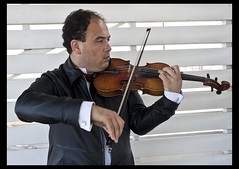
Hema Vijay writing in THE HINDU on October 18, 2011 describes what Dr. Preeti Raghavan is involved in.
Dr. Raghavan holds a beacon of hope for those who have been incapacitated by stroke. Her study of memory and movement in the field of neuroscience has aided many to lead near normal lives
She teaches the brain to make new connections; connections which could help stroke victims regain the ability to move a finger, hand, leg or arm. Preeti Raghavan, MD, and the ‘brain’ behind the Motor Recovery Research Laboratory at the Rusk Institute of Rehabilitation Medicine, the premier rehabilitation hospital in New York State, believes in the awesome potential of the human body.
For many years now, Dr. Raghavan has been reverse engineering the neural pathway of movements. “Even if a part of the brain has been affected by stroke, the person can still relearn the movement — through an alternate pathway in the brain,” she says. Dr. Raghavan studied medicine at the Annamalai University and later at New York before going on to make path-breaking findings.
It all began when she started studying how people perform movements. Think of this; we never consciously calculate the amount of pressure or the extent of the turn we need to give our fingers to hold a spoon, open a tap or shake hands. “But actually, even a simple movement requires complex planning, which we learn and store in our memories for reuse,” Dr. Raghavan explains.
Four years ago, Dr. Raghavan was studying movement in stroke patients by using a simple grip device with sensors that measured forces produced by fingers when a movement is executed. “These people couldn’t work out the force required to grasp and lift the object. Their old memories had been erased by the stroke, and new memories were not allowed to be formed, because of the damage to the neurological tissue,” she recounts. It was then that Dr. Raghavan made the amazing discovery that, if the same people lift the object with the intact hand and then repeat the movement with the affected hand, the affected hand is able to learn to perform the movement! “The idea is to use alternate connections. Amazingly, our brains have developed many redundant neural pathways for the same function. We utilise those preserved parts of the brain to revoke the lost function,” Dr. Raghavan adds.
For instance, one of Dr. Raghavan’s patients was a young musician who had had a successful bone marrow treatment for cancer, and later had a stroke. He recovered from it enough to run marathons, but still couldn’t manage movements such as holding a toothbrush, or tying shoe laces. Now, with Dr. Raghavan’s strategies, this young man is ‘learning’ to do it!
“Advances in research such as in Dr. Raghavan’s lab are increasing the understanding of cerebral physiology and function needed to build the necessary framework for better treatments specific to individuals with unique injuries. The work in Dr. Raghavan’s lab is a great example of translating basic sciences into clinical practice — and is creating excitement in neuroscience advances,” says Steven Flanagan, MD, clinical professor and chairman, Department of Rehabilitation Medicine and medical director, Rusk Institute at NYU Langone Medical Center.
Dr. Raghavan also zeroed in on musicians as subjects of study, because, musicians happen to be among the most dexterous users of their limbs. This is how she discovered that professional pianists who activate their upper back muscles while playing the piano tend not to suffer from overuse strain or injuries, compared to those who use just their fingers and arms. “It is a popular misconception that muscles are just tissues for execution of action. But muscles are also important for our kinesthetic sense. That is how expert musicians know how to apply just enough force,” she remarks. She uses such insights to help stroke victims and others in regaining optimum use of their limbs. Dr. Raghavan is also studying how listening to music and patterning rehabilitation exercises alongside musical rhythms may enhance the speed of recovery tremendously. “Rhythm assists movement because, we move in space and time”, she says.
Working with her team of doctors, engineers, statisticians, physical and occupational therapists, Dr. Raghavan is helping stroke victims and others get movement back into their lives. Finally, some advice for all of us: “We are moving all day long. The hierarchy of movement has to be efficient; otherwise it can lead to trouble.”
In addition to Dr. Raghavan’s program the ArmTutor is a compliment to restoring normal movement to the patient’s upper extremities.
The ArmTutor™ system has been developed to allow for functional rehabilitation of the upper extremity. The system consists of an ergonomic wearable arm brace and dedicated rehabilitation software. The ArmTutor™ system allows for a range of biomechanical evaluation including speed, passive and active range of motion and motion analysis of the upper extremity. Quantitative biomechanical data allow for objective evaluation and rehabilitation treatment follow up. The ArmTutor™ rehabilitation concept is based on performing controlled exercise rehabilitation practice at a patient customized level with real time accurate feedback on the patient’s performance. The exercises are designed in the form of challenging games that are suitable for a wide variety of neurological and orthopedic injury and disease.
The games challenge the patient to perform the exercise task to their best ability and to continue exercise practice.
The ArmTutor™ allows for isolated and a combination of elbow and three directional shoulder treatment. The system provides detailed exercise performance instructions and precise feedback on the patients exercise performance. Controlled exercise of multijoints within the normal movement pattern prevents the development of undesired and compensatory joint movement and ensures better performance of functional tasks.
The ArmTutor™ system is used by many leading rehabilitation centers worldwide and has full FDA and CE certification.
No comments:
Post a Comment